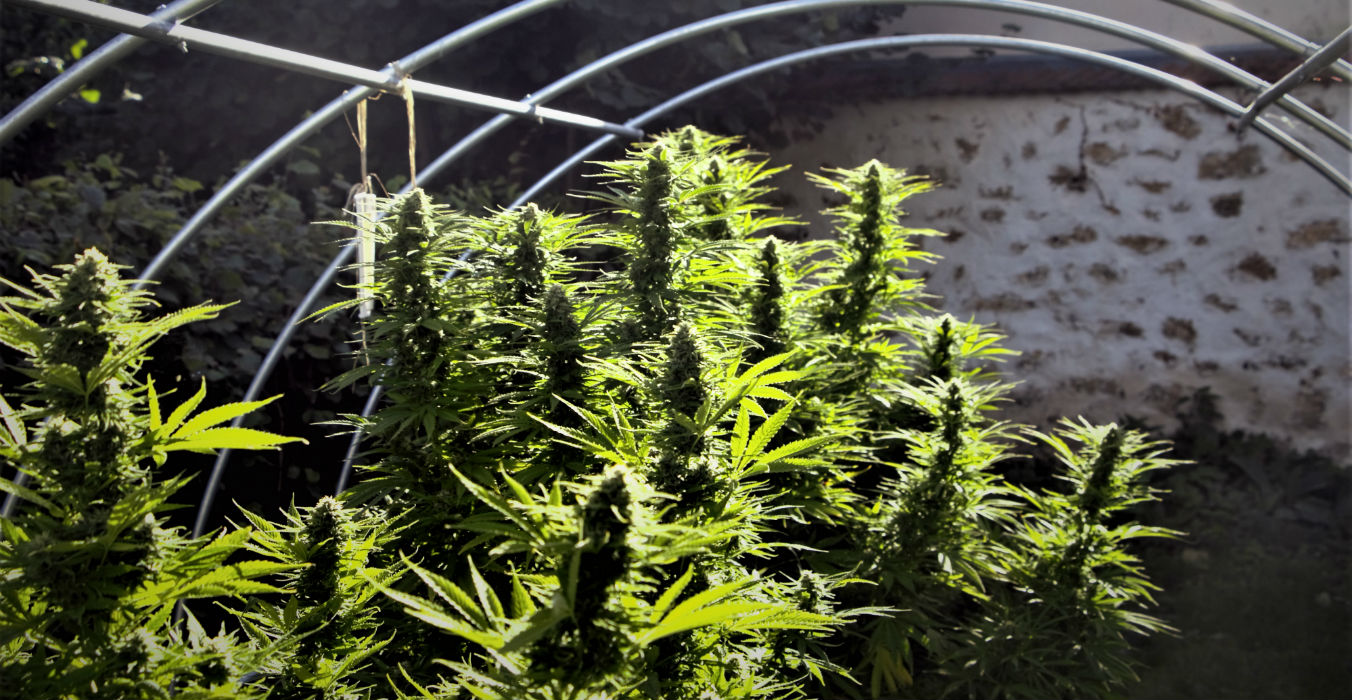- Is it possible to grow a successful crop outdoors with limited resources and in unusual or even unfavourable conditions? The answer is YES.
- If you’re not convinced, you can ask this sheepherder and cannabis lover who used the pasture fields in his region to grow his favourite strain: Dinafem’s heavy yielder Moby Dick XXL Autoflowering.
- Our partner Ganja Farmer brings you an exciting grow report featuring a most unusual guerrilla growing experience.

A privileged location
In the Causses, France, the altitude is 1,200 metres, which may seem like no big deal until you realise the cold night temperatures don't allow for a growing season of over 120 days. And this is precisely why I like Dinafem seeds so much. I find them to be really good with autoflowerings, I'm especially fond of their XXL versions, particularly Amnesia and Moby Dick, which can be harvested in just 100-110 days. Luckily, gone are the times when getting high on an auto made you feel heavy, now they're as good as any other strain but with the added benefit of a much shorter life cycle.
My pasture fields and the shed where I take shelter at night are 27 km from the first shops and the owner of the cattle I'm taking care of has to quad ride for 15 km in poor mountain road conditions to keep me well-supplied - which he does once a week. In five years, I haven't seen a soul in these surroundings, so there's no need to say that this is the perfect spot for a cannabis grow. There's excellent soil quality, with an ideal pH of 5-6, and although the temperature tends to drop quite a lot at night, it is never too hot during the day. Plus, the bounteous June and July sun promotes the growth of really nice buds.
Germination matters
I germinate the seeds upon my arrival on Tuesday 12 April. In my early days as a grower I used to lose almost half my seeds during this crucial step, but now I follow a highly rigorous process to ensure proper germination. First, I leave the seeds to soak in rainwater for fifteen hours - not one more, though, otherwise they could get damaged - and then I place them in peat pots with germination soil for easier transplant. The soil needs to be barely moist, so avoid overwatering to keep the seeds protected. Equally important is the temperature, which should range between 18 and 20 ºC and remain constant. Next, I put some big, flat stones by the fireplace of the shed for heat storage and I place the pots containing the seeds on top. Also, I use a thermometer to keep the temperature under control. With this system, I manage to germinate nineteen out of twenty seeds.
It's early May, but still too soon to take the young seedlings outside without protection. Thus, I cobble together a wind-sheltered, south-facing greenhouse next to my shed using a dry-stone wall and a transparent PVC cover fixed with stones to three-metre-long poles cut down from firs. This allows me to keep the plants outside without having to wait for the temperatures to pass the 20 ºC mark - 10 ºC at night. I guess I could have transplanted the seeds as early as 15 May, but in highland areas you never now - sometimes summer seems reluctant to set in and a greenhouse, however rudimentary, is a great way to prolong the growing season from four to six weeks.
An amazing guerrilla growing experience
I kill the downtime by preparing the soil - autoflowerings need about one square metre per plant. I choose a sunlit spot to make sure the plants enjoy a good fifteen hours of sunshine by mid-June, which they really love! And since I'm in the mountains, I work on slightly sloping ground (10%) - grass is like vine, it loves that oblique sunlight that would only damage other not-so-sun-dependent plants. I work each one-square-metre bed with two spades, I add a barrowful of sheep manure - bird manure works better but mine has gone bad - and I dig 5/10-cm-deep irrigation furrows.
I transplant on Sunday 22 May, forty days after sowing. The plants are in the vegetative stage, have reached a height of 30 cm and have developed six branches. On 4 June, when they pass the 50 cm mark, the first filaments herald the flowering period; things don't get serious though until 20 June, seventy days after sowing. Autoflowerings love the endless June days, which causes them to stretch a lot: from 67 cm on 20 June to 1.29 m on 9 July, just nineteen days. This year the sun is particularly bright and the buds thrive wonderfully. At this delicate stage, it is essential to avoid all possible sources of stress, but luckily my four sheepdogs have clearly understood they are strictly forbidden from hovering around the plants - many animals like to graze the leaves of plants and this also applies to cattle.
On 14 July, 94 days after sowing, I start to consider harvesting. The weather's beautiful, not a single cloud in the sky, so I decide to wait a few more days. Just like tomatoes, I like my grass to be well ripe, so I don't need to observe the trichomes under the microscope. I cease watering ten days prior to the expected harvest date, at which point all depends upon the weather - harvesting in dry conditions is an absolute must. On 22 July a storm starts to build up, it's time to harvest! The biggest plant, named miss Maggie, is 1.32 metres tall and has produced 228 grams of trimmed, dried bud. Out of the nineteen plants, four have produce 200 grams; three, about 170; eight, some 100 to 150, and the smallest one, a respectable 78 grams. The 2016 harvest, thus, amounts to 1,759 grams.
The growing process in numbers:
- Sowing on 12 April and harvest on 22 July - 102 days or 14 weeks
- About 50 days of growing and 50 days of flowering
- Day temperature: 12/32 ºC (minimum/maximum)
- Night temperature: 8/19 °C (minimum/maximum)
- 95 days of sunlight and 3 cm of rain per square meter
- Manure: Potassium-rich, organic sheep manure (decomposition period of at least two years)
- Yield: 1,759 g divided into 19 plants - an average of 90 g per plant
- Money investment: €180
- Time investment: about 10 hours (half for trimming and drying)



Comments from our readers
There are no comments yet. Would you like to be the first?
Leave a comment!Did you like this post?
Your opinion about our seeds is very important to us and can help other users a lot (your email address won't be made public).